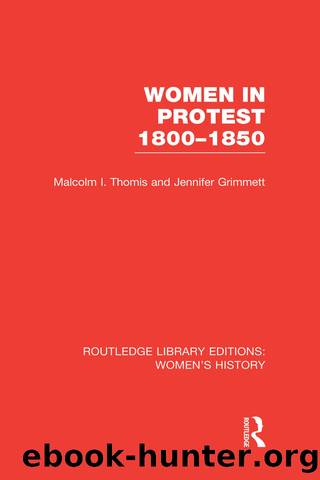Women in Protest 1800-1850 by Malcolm I. Thomis Jennifer Grimmett

Author:Malcolm I. Thomis, Jennifer Grimmett [Malcolm I. Thomis, Jennifer Grimmett]
Language: eng
Format: epub
Tags: History, General, Modern, 19th Century, Social History, Philosophy, Movements, Existentialism, Social Science, Women's Studies
ISBN: 9781000155594
Google: HDXfDwAAQBAJ
Publisher: Routledge
Published: 2020-04-28T15:59:51+00:00
5 âPETTICOAT REFORMERSâ
The emergence of women as a force in British politics occurs in that post-Napoleonic War period which also produced the first popular working-class reform movements. Before this time there had been popular movements in the shape of food riots, reform movements such as that of the London Corresponding Society which involved an artisan elite, and revolutionary movements of obscure history and unknown strength which drew other working-class men into politics. But prior to 1816 there had been no open political reform movements which attracted large numbers of working-class men and became national in scope. Similarly with women's involvement, the pre-1816 years had produced little popular participation in political causes. The 'revolutionary underground' was almost certainly a male monopoly if the insurrectionary movements of post-war Britain offer any guidance to its earlier composition, and the same is probably true of the reform societies. Gwyn Williams records that at the October meeting of the London Corresponding Society at Copenhagen House in 1795 'hordes of women and children' took part in what was probably one of the largest gatherings ever to assemble in London, but he relates this to the famine conditions of this year and not to any conscious turning of women towards political processes.1
The riot was still their popular form of expression, even when there were political causes involved, as in the Gordon Riots of 1780 or in the anti-militia and anti-recruitment riots of the same period. These were particularly extensive in Scotland, and, though only 6 per cent of those arrested and charged in connection with them were women, it has none the less been shown that women were very actively involved in many disturbances and displayed a courage and at times a violence to equal their contributions to many food-rioting situations.2 Even in England, as late as March 1812, when three men of Brighouse were on trial for riot and assault upon a recruiting party, it was reported that a crowd of up to a hundred had been spurred on by a woman who had cried out 'Murder them if they do not go away.'3 Yet these riots, despite their apparent political content, were more concerned with issues that affected the domestic economy, the family and personal relations. The Scottish women had protested that it was a hard thing to bring up children alone and that they were not prepared to let their menfolk be carried off; their attacks upon press gangs and military escorts and the crowds dramatically raised, as at East Tranent in 1797 by a woman beating a drum (she was subsequently killed in clashes with the troops), were all a reflection of immediate economic and domestic concerns and not some pronunciation on great national issues.4
When the war ended and 'whilst', in Samuel Bamford's memorable words, 'the laurels were yet cool on the brows of our victorious soldiers on their second occupation of Paris, the elements of convulsion were at work amongst the masses of our labouring population'. Bamford listed the riots and demonstrations
Download
This site does not store any files on its server. We only index and link to content provided by other sites. Please contact the content providers to delete copyright contents if any and email us, we'll remove relevant links or contents immediately.
| Africa | Americas |
| Arctic & Antarctica | Asia |
| Australia & Oceania | Europe |
| Middle East | Russia |
| United States | World |
| Ancient Civilizations | Military |
| Historical Study & Educational Resources |
Never by Ken Follett(2865)
The Man Who Died Twice by Richard Osman(2287)
Machine Learning at Scale with H2O by Gregory Keys | David Whiting(2252)
Fairy Tale by Stephen King(2056)
Will by Will Smith(2023)
Rationality by Steven Pinker(1757)
The Dawn of Everything: A New History of Humanity by David Graeber & David Wengrow(1561)
The Dark Hours by Michael Connelly(1557)
Principles for Dealing With the Changing World Order: Why Nations Succeed and Fail by Ray Dalio(1367)
Friends, Lovers, and the Big Terrible Thing by Matthew Perry(1314)
A Short History of War by Jeremy Black(1294)
HBR's 10 Must Reads 2022 by Harvard Business Review(1249)
Go Tell the Bees That I Am Gone by Diana Gabaldon(1230)
Can't Hurt Me: Master Your Mind and Defy the Odds - Clean Edition by David Goggins(1215)
515945210 by Unknown(1205)
Fear No Evil by James Patterson(1101)
443319537 by Unknown(1068)
Works by Richard Wright(1016)
The 1619 Project by Unknown(985)
